Research on Gas Drainage Pipeline Leakage Detection and Localization Based on the Pressure Gradient Method
Abstract
:1. Introduction
2. Analysis of the Basic Law of Gas Flow in the Drainage Pipeline
2.1. Basic Equations of Gas Flow in the Pipeline
2.1.1. Pipeline Gas Flow Continuity Equation
2.1.2. Pipeline Gas Flow Energy Equation
2.1.3. Pipeline Gas Flow Motion Equation
2.2. Pipeline Network Resistance Calculation Based on the Pressure Gradient Method
2.3. Principle of Pipeline Leakage Detection and Localization Based on the Pressure Gradient Method
3. Results and Discussion
3.1. Numerical Simulation Study on the Leakage Detection and Localization Method Based on the Pressure Gradient Method
3.1.1. Gas Drainage Pipeline Model Establishment
3.1.2. Meshing and Boundary Condition Establishment
3.2. Drainage Pipeline Leakage Numerical Simulation Result Analysis
3.2.1. Effect of Leakage Degree on Pipeline Fluid Motion State
3.2.2. Effect of Leakage Position on Pipeline Fluid Motion State
3.2.3. Effect of Negative Pressure on Pipeline Leakage Fluid Motion State
3.3. Accuracy Analysis of Gas Drainage Pipeline Leakage Detection and Localization Based on the Pressure Gradient Method
3.4. On-Site Test Result Analysis of Leakage Detection and Localization Based on the Pressure Gradient Method
3.5. Thoughts and Prospects of Pressure Gradient Method Gas Drainage Pipeline Leakage Detection Technology
4. Conclusions
Author Contributions
Funding
Data Availability Statement
Conflicts of Interest
References
- Liu, Y.; Liang, Y.; Li, Q. Cause Analysis of Coal Mine Gas Accidents in China Based on Association Rules. Appl. Sci. 2023, 13, 9266. [Google Scholar] [CrossRef]
- Wang, C.; Yang, S.; Yang, D.; Li, X.; Jiang, C. Experimental analysis of the intensity and evolution of coal and gas outbursts. Fuel 2018, 226, 252–262. [Google Scholar] [CrossRef]
- Zhao, W.; Dong, H.; Yuan, Y.; Wang, K.; Song, Y. Evolution law of coal and gas outburst hole shapes with varying underground stress conditions: Numerical analysis and on-scene evidence. Fuel 2024, 360, 130531. [Google Scholar] [CrossRef]
- Zhou, A.; Xu, Z.; Wang, K.; Wang, Y.; An, J.; Shi, Z. Coal mine gas migration model establishment and gas extraction technology field application research. Fuel 2023, 349, 128650. [Google Scholar] [CrossRef]
- Wang, Z.; Sun, Y.; Wang, Y.; Zhang, J.; Sun, Z. A coupled model of air leakage in gas drainage and an active support sealing method for improving drainage performance. Fuel 2019, 237, 1217–1227. [Google Scholar] [CrossRef]
- Zhang, J.; Liu, Y.; Ren, P.; Han, H.; Zhang, S. A fully multifield coupling model of gas extraction and air leakage for in-seam borehole. Energy Rep. 2021, 7, 1293–1305. [Google Scholar] [CrossRef]
- Liu, T.; Lin, B.; Yang, W.; Liu, T.; Kong, J.; Huang, Z.; Wang, R.; Zhao, Y. Dynamic diffusion-based multifield coupling model for gas drainage. J. Nat. Gas Sci. Eng. 2017, 44, 233–249. [Google Scholar] [CrossRef]
- Shu, L. Study on Gas Extraction Technology for Goaf Using L-Shaped Borehole on the Ground. Appl. Sci. 2024, 14, 1594. [Google Scholar] [CrossRef]
- Yang, P. Cause Analysis and Repair Technology of Gas Leakage in Gas Extraction Pipeline. Master’s Thesis, Xi’an University of Science and Technology, Xi’an, China, 2022. [Google Scholar]
- Han, Q.Z.; Xiang, J.; Shao, H. Research on leakage positioning technology of gas drainage pipelines. China Coal 2011, 37, 90–93. [Google Scholar]
- Pei, W. Experimental Study on the Leak Detectionand Localization System of Main Methane Drainage Pipeline. Master’s Thesis, China University of Mining and Technology, Xuzhou, China, 2014. [Google Scholar]
- Lu, H.; Iseley, T.; Behbahani, S.; Fu, L. Leakage detection techniques for oil and gas pipelines: State-of-the-art. Tunn. Undergr. Space Technol. 2020, 98, 103249. [Google Scholar] [CrossRef]
- Sekhavati, J.; Hashemabadi, S.H.; Soroush, M. Computational methods for pipeline leakage detection and localization: A review and comparative study. J. Loss Prev. Process Ind. 2022, 77, 104771. [Google Scholar] [CrossRef]
- El-Shiekh, T.M. Leak Detection Methods in Transmission Pipelines. Energy Sources Part A Recovery Util. Environ. Eff. 2010, 32, 715–726. [Google Scholar] [CrossRef]
- Tian, X.; Jiao, W.; Liu, T. Intelligent leak detection method for low-pressure gas pipeline inside buildings based on pressure fluctuation identification. J. Civ. Struct. Health Monit. 2022, 12, 1191–1208. [Google Scholar] [CrossRef]
- Yin, S.; Liu, Y.; Han, W. Single-point location algorithm based on an acceleration sensor for pipeline leak detection. Measurement 2020, 163, 108021. [Google Scholar] [CrossRef]
- Bui Quy, T.; Kim, J.-M. Leak detection in a gas pipeline using spectral portrait of acoustic emission signals. Measurement 2020, 152, 107403. [Google Scholar] [CrossRef]
- He, N.; Qian, C.; Li, R.; Zhang, M. An improved pipeline leak detection and localization method based on compressed sensing and event-triggered particle filter. J. Frankl. Inst. 2021, 358, 8085–8108. [Google Scholar] [CrossRef]
- Zhou, J.; Lin, H.; Li, S.; Jin, H.; Zhao, B.; Liu, S. Leakage diagnosis and localization of the gas extraction pipeline based on SA-PSO BP neural network. Reliab. Eng. Syst. Saf. 2023, 232, 109051. [Google Scholar] [CrossRef]
- Zuo, J.; Zhang, Y.; Xu, H.; Zhu, X.; Zhao, Z.; Wei, X.; Wang, X. Pipeline Leak Detection Technology Based on Distributed Optical Fiber Acoustic Sensing System. IEEE Access 2020, 8, 30789–30796. [Google Scholar] [CrossRef]
- Zhang, T.; Tan, Y.; Zhang, X.; Zhao, J. A novel hybrid technique for leak detection and location in straight pipelines. J. Loss Prev. Process Ind. 2015, 35, 157–168. [Google Scholar] [CrossRef]
- Liu, B.; Jiang, Z.; Nie, W. Negative pressure wave denoising based on VMD and its application in pipeline leak location. J. Mech. Sci. Technol. 2021, 35, 5023–5032. [Google Scholar] [CrossRef]
- She, X.Z.; Hou, Q.; Yang, L. Leak Detection Technology in Underground Gas Extraction Pipe Network. Saf. Coal Mines 2013, 44, 75–77. [Google Scholar]
- Lei, B.W.; Li, X.; Liu, Z. Research on Diagnosis Method for Gas Drainage Pipeline Network Running State Based on Pressure Measurement. Min. Saf. Environ. Prot. 2017, 44, 32–35+52. [Google Scholar]
- Mao, J.R.; Liu, X.; Wang, S. Leak Detection Analysis and Maintenance of Gas Extraction Pipeline Based on Pressure Gradient Method. J. Kunming Metall. Coll. 2020, 36, 15–19+46. [Google Scholar]
- Zhang, Y.Z.; Zhang, L.; Zhang, H.; Li, W.; Liu, Y.; Sang, C. Research on leakage positioning method of underground gas extraction main pipeline based on transient model. J. Mine Autom. 2021, 47, 55–60. [Google Scholar]
- Guo, S. A Leakage Detection Technology for Gas Drainage Pipeline Based on Ultrasonic Inspection. Min. Saf. Environ. Prot. 2014, 41, 88–91. [Google Scholar]
- Cai, J.; Wu, J.; Yuan, S.; Liu, Z.; Kong, D. Numerical analysis of multi-factors effects on the leakage and gas diffusion of gas drainage pipeline in underground coal mines. Process Saf. Environ. Prot. 2021, 151, 166–181. [Google Scholar] [CrossRef]
- Zhao, C.; He, B.; Wang, Y.; Wu, B. Experimental study on the diagnosis of operation state of gas extraction pipeline based on pressure gradient method. Energy Sources Part A Recovery Util. Environ. Eff. 2021, 1–14. [Google Scholar] [CrossRef]
- Cui, C.; Jiang, S.; He, X.; Wang, K.; Shao, H.; Wu, Z. Experimental study on the location of gas drainage pipeline leak using cellular automata. J. Loss Prev. Process Ind. 2018, 56, 68–77. [Google Scholar] [CrossRef]
- da Cruz, R.P.; da Silva, F.V.; Fileti, A.M. Machine learning and acoustic method applied to leak detection and location in low-pressure gas pipelines. Clean Technol. Environ. Policy 2020, 22, 627–638. [Google Scholar] [CrossRef]
- Ullah, N.; Ahmed, Z.; Kim, J.-M. Pipeline Leakage Detection Using Acoustic Emission and Machine Learning Algorithms. Sensors 2023, 23, 3226. [Google Scholar] [CrossRef]
- Lin, R. Research on Oil Pipeline Leakage Detection Method Based on Deep Learning. Master’s Thesis, Dalian University of Technology, Dalian, China, 2022. [Google Scholar]
- Ren, H. Adaptive Control Model of Gas Drainage Parameters in Coal Mine. Master’s Thesis, China University of Mining and Technology, Xuzhou, China, 2021. [Google Scholar]
- Liu, Z. Experimental Research on the Optimizing Operation Methods of Pipe Network of Gas Extraction in Coal Mine. Ph.D. Thesis, China University of Mining and Technology (Beijing), Beijing, China, 2017. [Google Scholar]

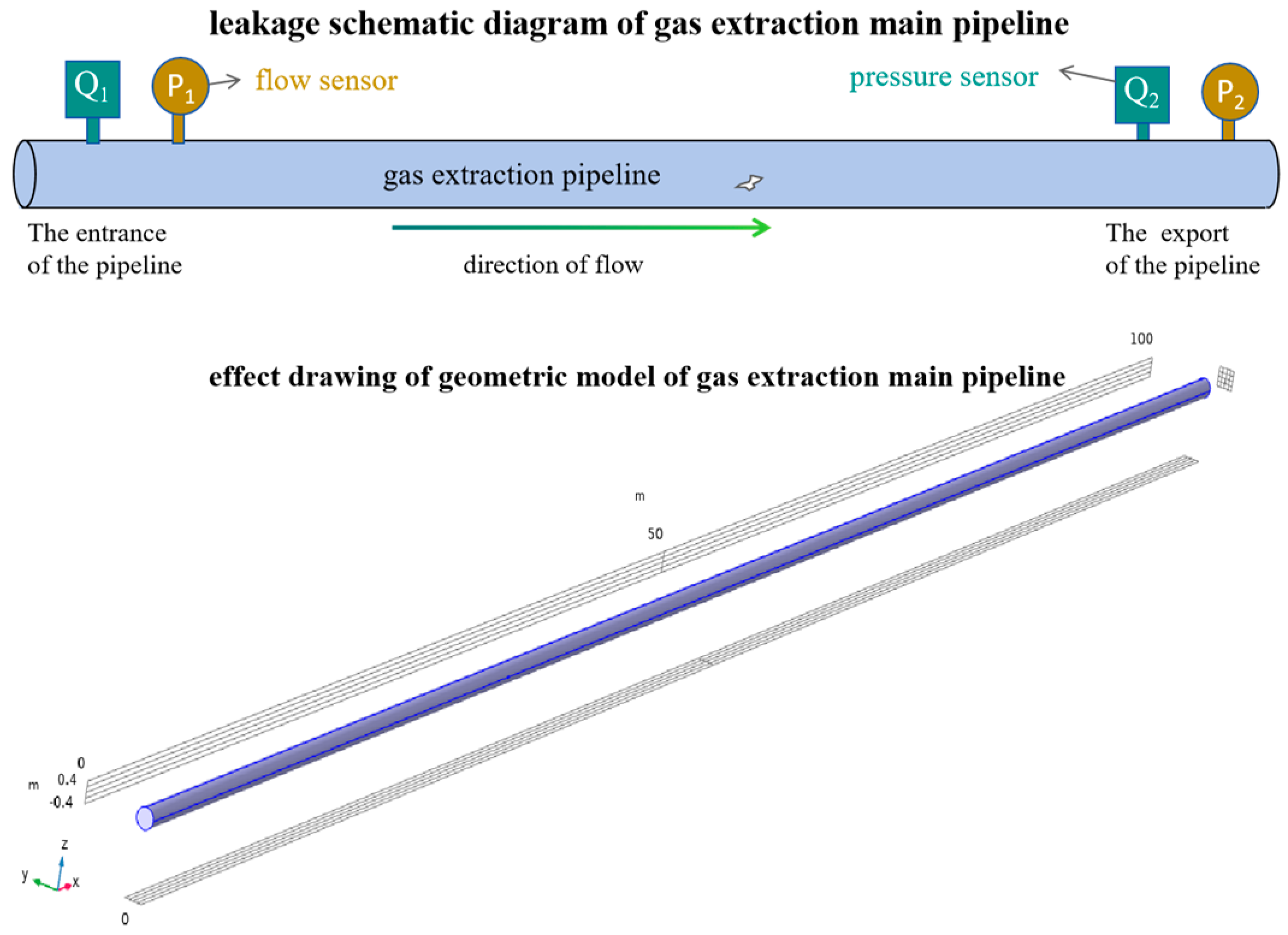
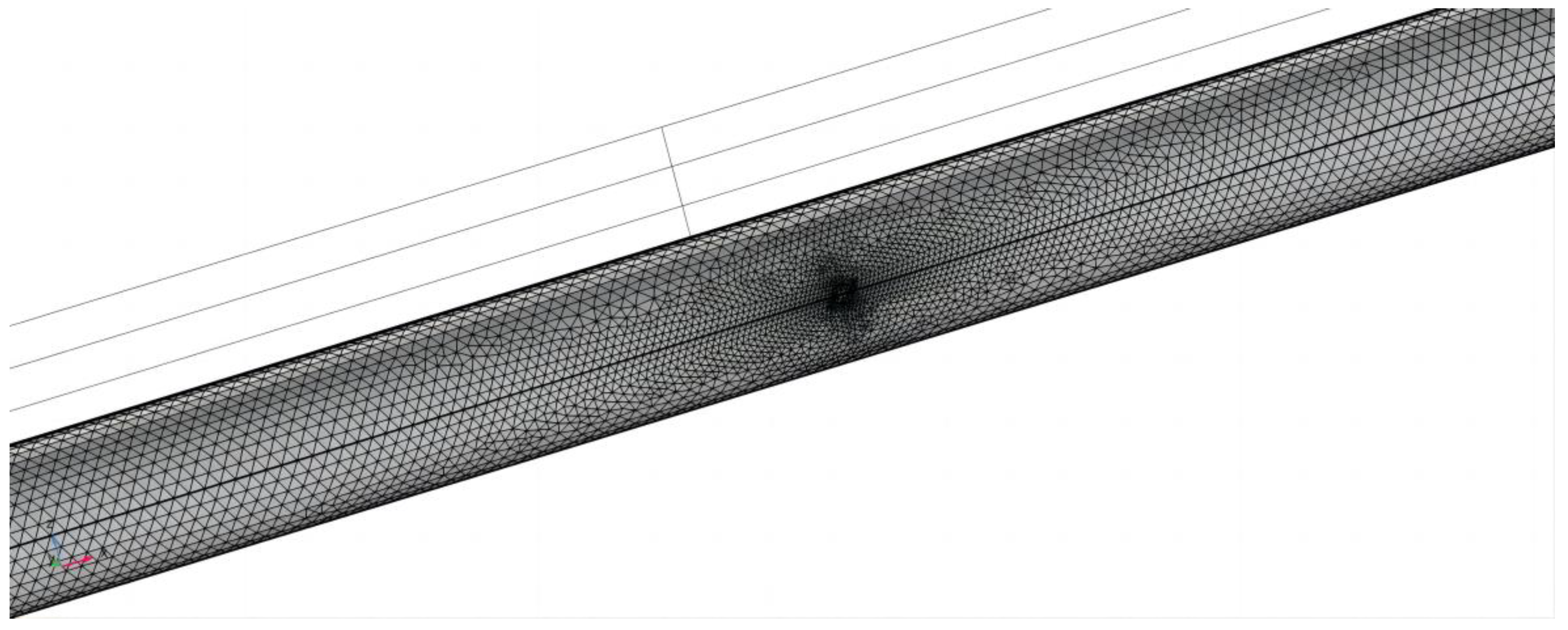
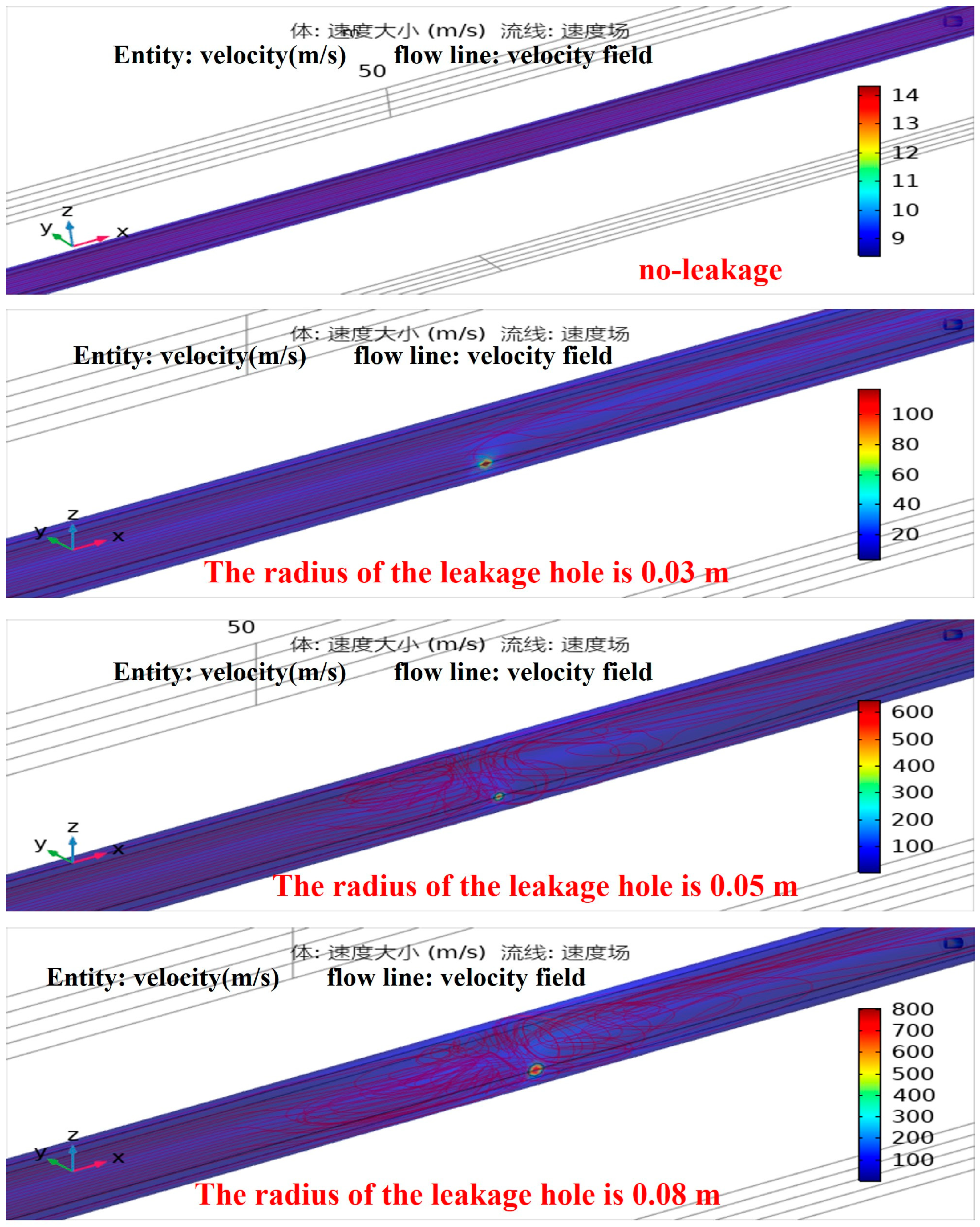
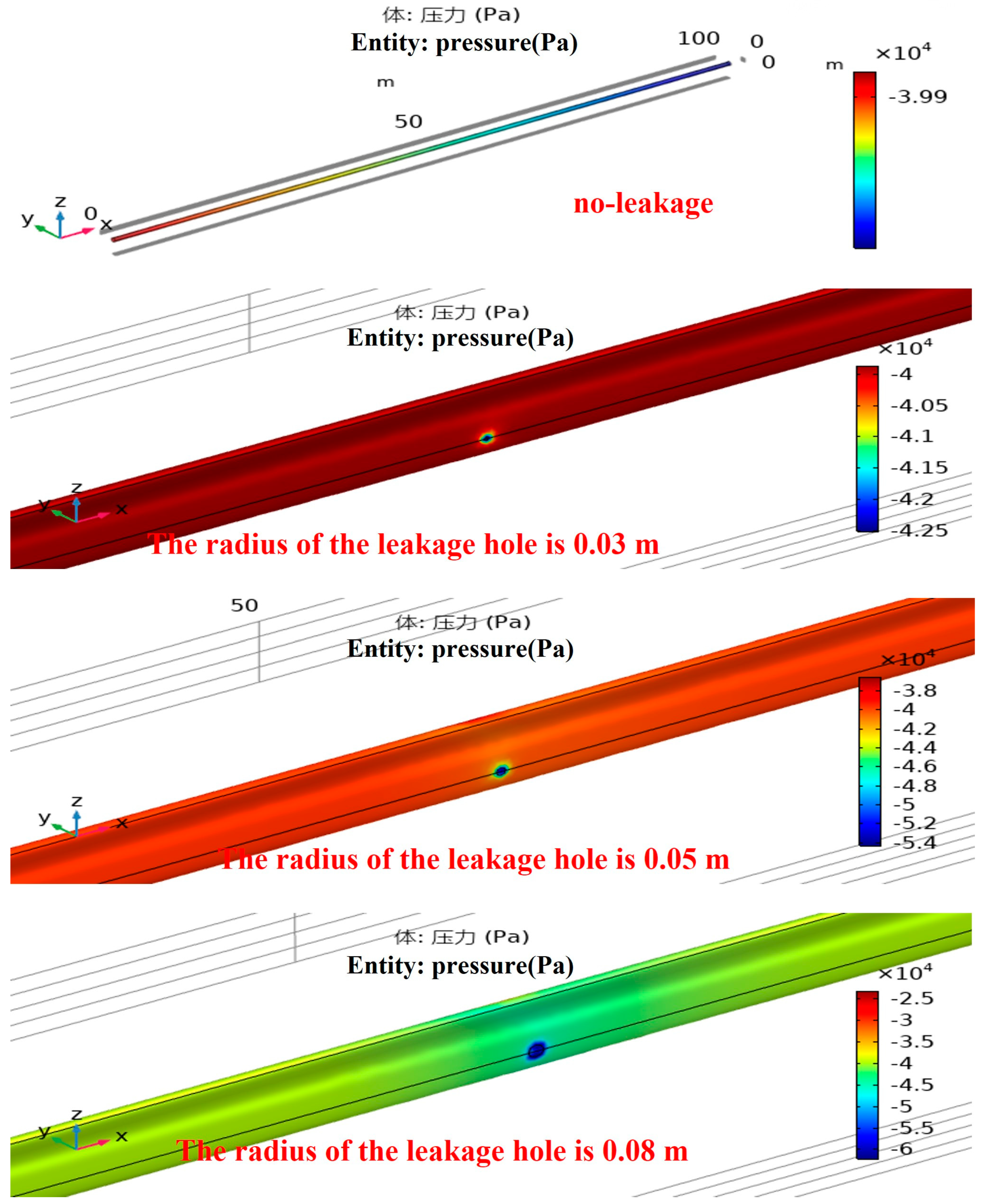
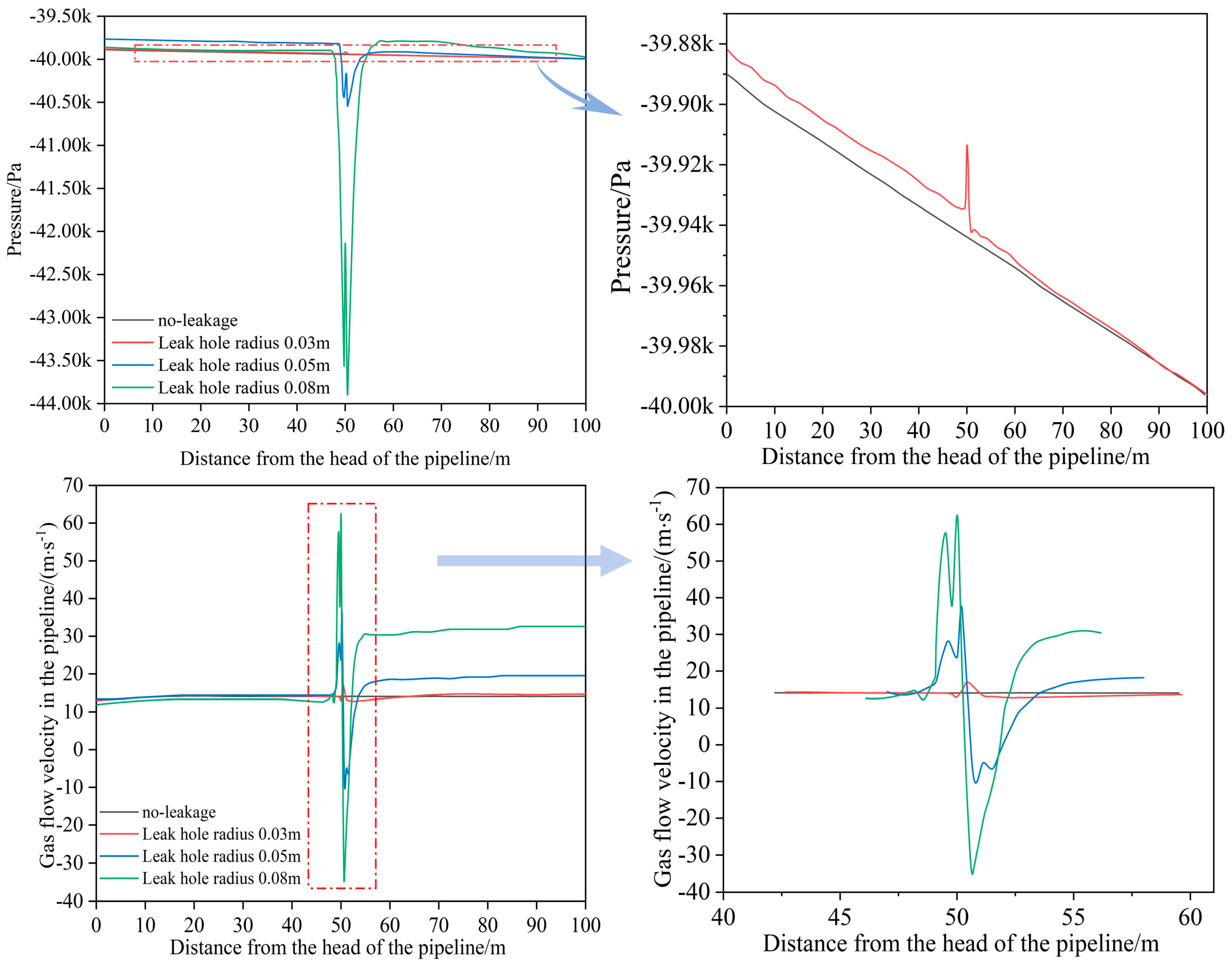
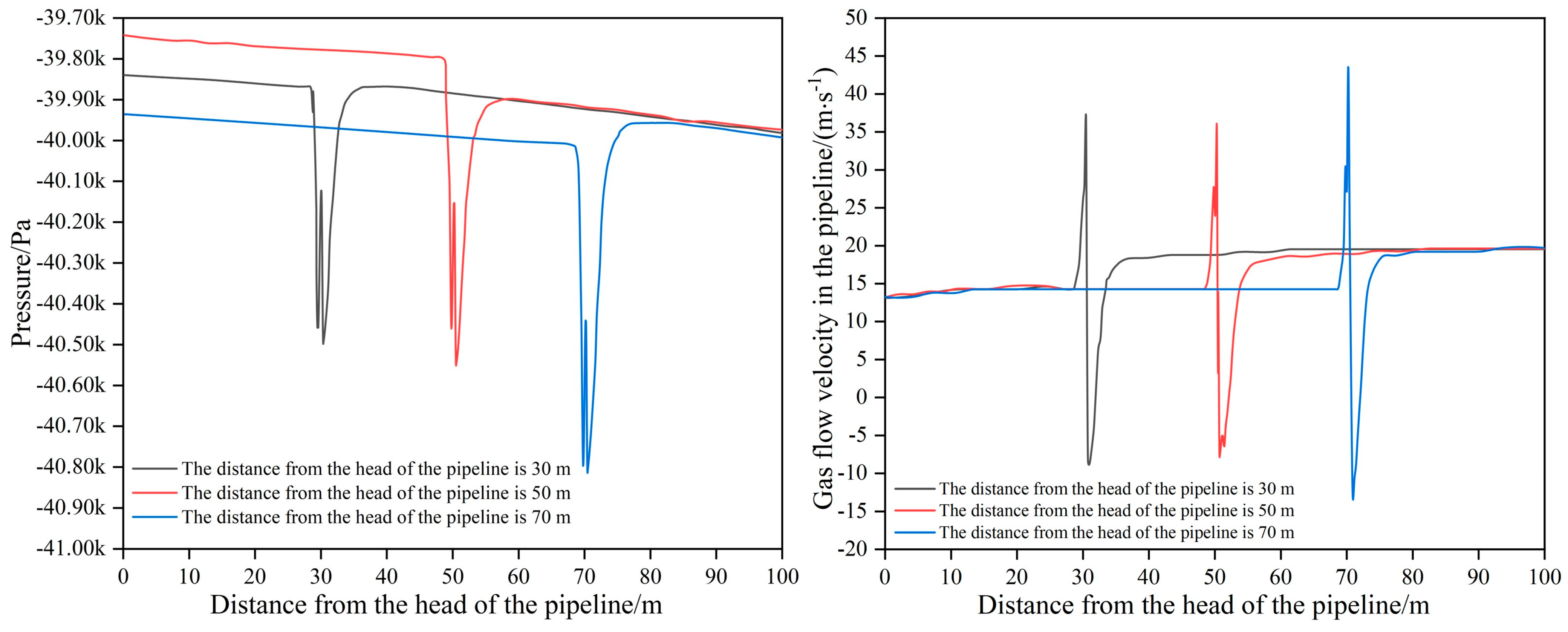
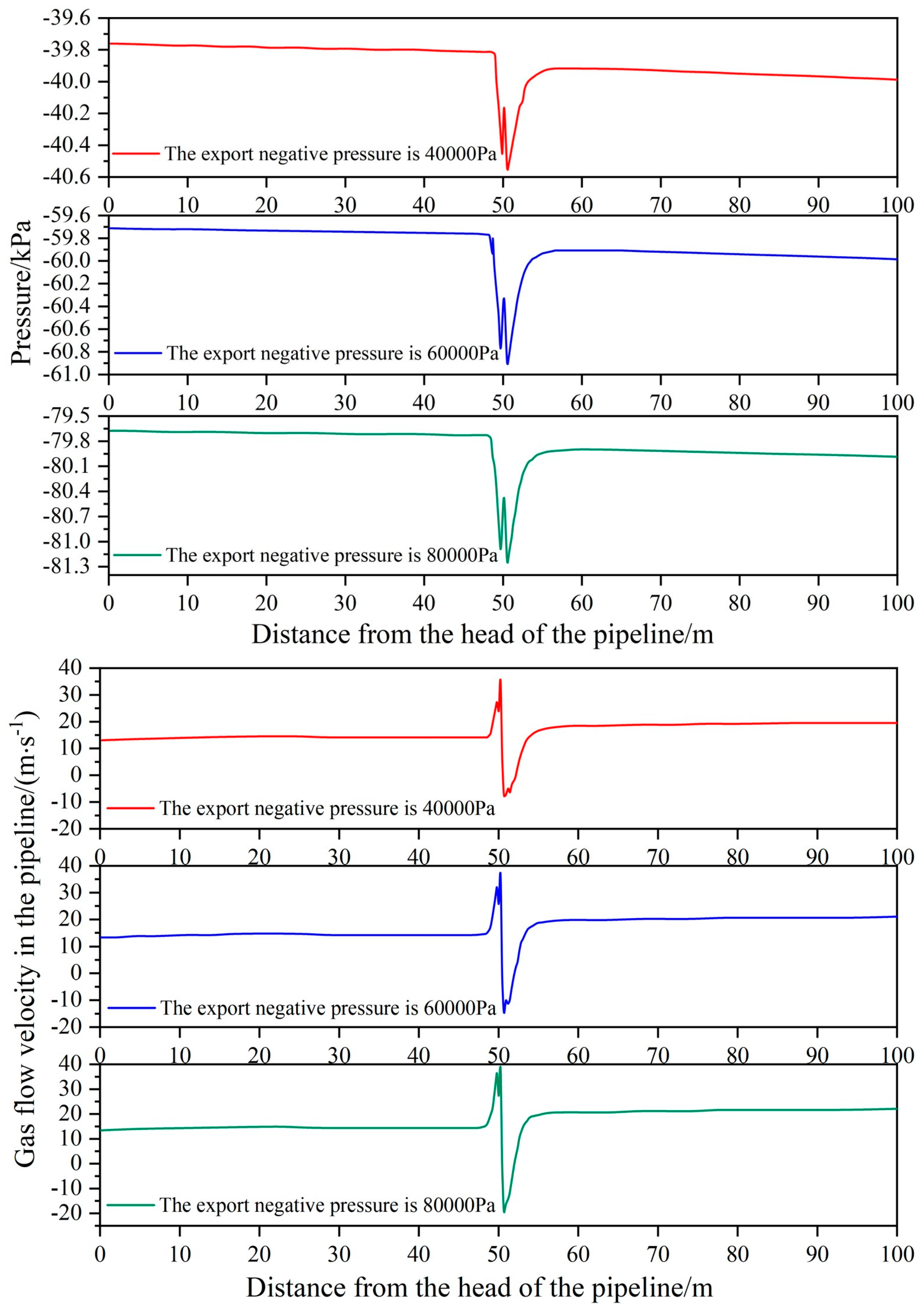
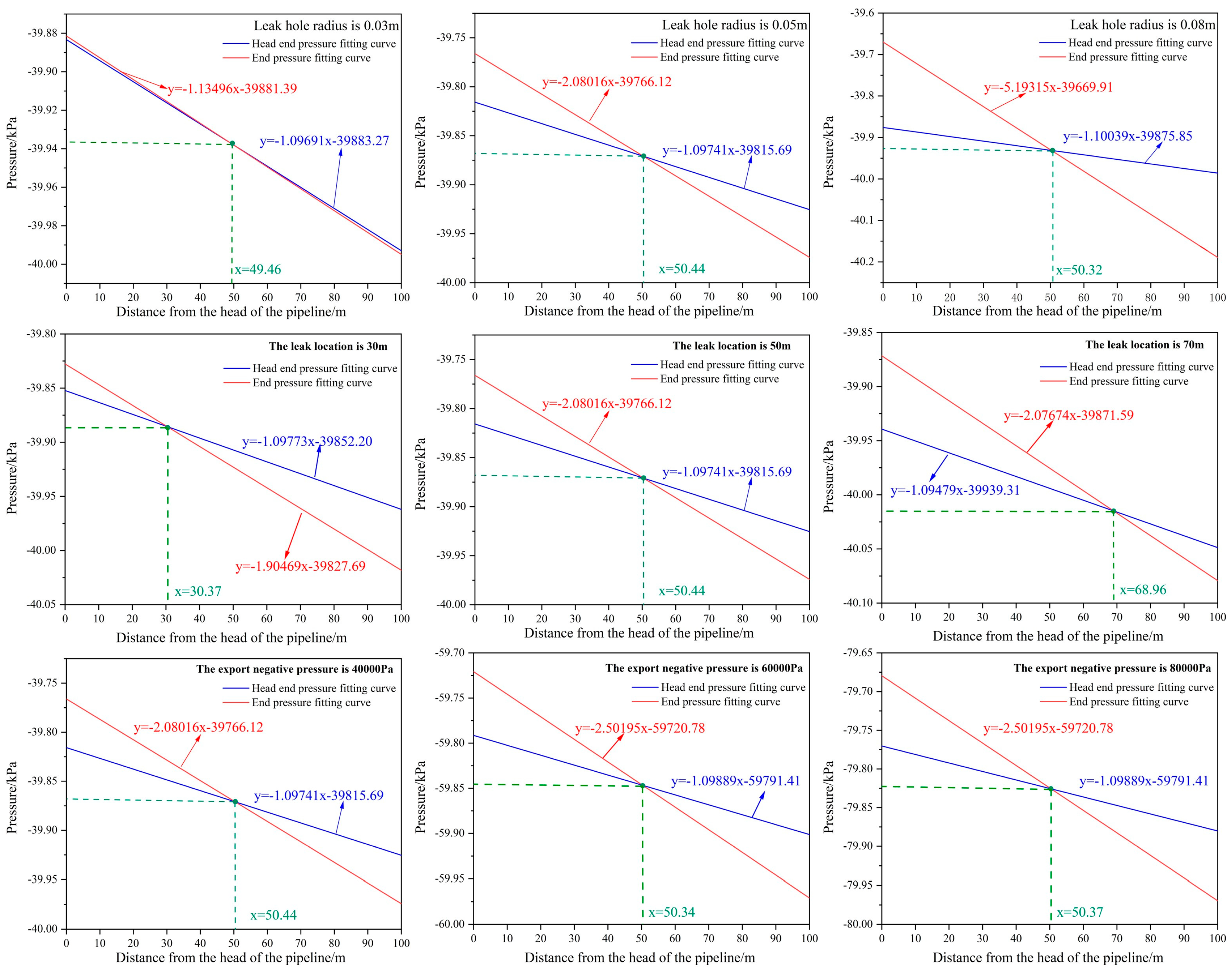




| Required Parameters | 8421 Highly Located Drainage Roadway Measurement Starting Point | 8421 Highly Located Drainage Roadway Measurement End Point |
|---|---|---|
| Local resistance coefficient () | 1.1 | 1.1 |
| Pipeline overall correction coefficient () | 1.17 | 1.17 |
| Pipeline length (L) | 1685 m | 1685 m |
| Pipeline roughness () | 0.0005 m | 0.0005 m |
| Pipeline inner diameter (d) | 70 cm | 70 cm |
| STP gas viscosity () | 1.5787 × 10−5 m2/s | 1.5787 × 10−5 m2/s |
| STP pipeline flow () | 19,440 m3/h | 27,000 m3/h |
| STP gas density () | 1.1350 kg/m3 | 1.1836 kg/m3 |
| STP absolute temperature () | 273 K | 273 K |
| Pipeline absolute temperature (T) | 286.5 K | 285.8 K |
| STP atmospheric pressure () | 101,325 Pa | 101,325 Pa |
| Pipeline absolute pressure (P) | 95,159 Pa | 87,065 Pa |
| Pipeline resistance loss (H) | 4459.49 Pa | 9062.87 Pa |
Disclaimer/Publisher’s Note: The statements, opinions and data contained in all publications are solely those of the individual author(s) and contributor(s) and not of MDPI and/or the editor(s). MDPI and/or the editor(s) disclaim responsibility for any injury to people or property resulting from any ideas, methods, instructions or products referred to in the content. |
© 2024 by the authors. Licensee MDPI, Basel, Switzerland. This article is an open access article distributed under the terms and conditions of the Creative Commons Attribution (CC BY) license (https://creativecommons.org/licenses/by/4.0/).
Share and Cite
Zhang, H.; Shen, M.; Huo, Z.; Zhang, Y.; Shu, L.; Li, Y. Research on Gas Drainage Pipeline Leakage Detection and Localization Based on the Pressure Gradient Method. Processes 2024, 12, 1590. https://doi.org/10.3390/pr12081590
Zhang H, Shen M, Huo Z, Zhang Y, Shu L, Li Y. Research on Gas Drainage Pipeline Leakage Detection and Localization Based on the Pressure Gradient Method. Processes. 2024; 12(8):1590. https://doi.org/10.3390/pr12081590
Chicago/Turabian StyleZhang, Huijie, Maoliang Shen, Zhonggang Huo, Yibin Zhang, Longyong Shu, and Yang Li. 2024. "Research on Gas Drainage Pipeline Leakage Detection and Localization Based on the Pressure Gradient Method" Processes 12, no. 8: 1590. https://doi.org/10.3390/pr12081590






